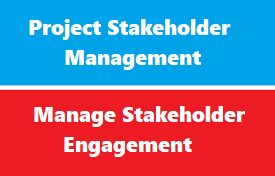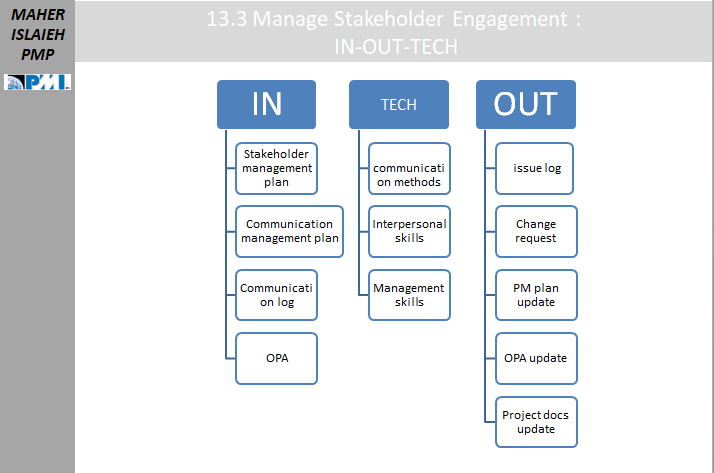introduction
Manage Stakeholder Engagement is the process of communicating and working with stakeholders to meet their needs/expectations, address issues as they occur, and foster appropriate stakeholder engagement in project activities throughout the project life cycle
. The key benefit of this process is that it allows the project manager to increase support and minimize resistance from stakeholders, significantly increasing the chances to achieve project success.
Guiding of Stakeholder Engagement
Guiding Principles of Stakeholder Engagement
Identify all stakeholders.
- A stakeholder is anyone who has an interest (positive or negative) in what you are trying to achieve.
- Anyone who is going to win when you win, or lose when you win, is a stakeholder.
- Even if their loss is simply having to do their job a different way, they could be a very important stakeholder. This makes for a very large group of people.
Focus on stakeholders
- who have the most power to help or hinder your goal.
- This narrows the field down to help you focus your engagement on the stakeholders who are most important.
- It is also a good idea to check out those stakeholders who have the greatest interest in your result
focus what you want from each stakeholder.
- You may not necessarily communicate your wants directly with them, but at least you need to know specifically what you are shooting for.
Connect stakeholders’ interests to your goals.
- To engage positive stakeholders, you need to connect their agenda with your goal, and disconnect with negative ones.
- Those with a positive interest in your success will work harder for you if they can see how it serves their purpose and helps them achieve their goals. Conversely, with negative interest, you really need to remove yourself from their radar.
Increase your goal’s priority.
- To achieve higher engagement, you need to increase your goal’s priority in the mind of positive stakeholders, and lessen it with negative stakeholders.
- you might gain quite a bit from proactively engaging those who have a negative interest. Rather than leave them guessing, show them how it doesn’t affect them.
Don’t always deal directly with stakeholders.
- Often, the most powerful people will be inaccessible (or at least not readily available) as they stride around the corridors of power.
- That doesn’t mean they are not a stakeholder; it’s just that you have to be more creative in your approach.
- Seek out others who influence them and engage with them instead.
- Then, these intermediaries can influence on your behalf.
Attain enough agreement to secure goal.
- You don’t have to get all stakeholders to agree on everything—just enough to secure your goal. As a result, how you define your goal is a nuance to consider.
- If you want to get a long-term sustainable result, you will need to get more stakeholders to agree than if your result is a simple one-off piece of work never to be repeated.
process inputs -techniques -outputs
Inputs
- Stakeholder management plan
- Communication management plan
- Communication log
OPA
- Techniques
- communication methods
- Interpersonal skills
- Management skills
Outputs
- issue log
- Change request
- PM plan update
- OPA update
- Project docs update
process inputs
Manage Stakeholder Engagement: Inputs
Project Management Plan
PM plan include :
- Stakeholder management plan–this provides guidelines and information on all stakeholder engagement processes, including this one of managing stakeholder expectations.
- Communications management plan–describes methods, formats, and technologies to be used for stakeholder communication
- Risk management plan–describes the risk categories, risk appetites, and reporting formats that can be used to manage stakeholder engagement.
- Change management plan–describes the process for submitting, evaluating and implementing changes to the project.
Project Documents
- Change log–change requests are communicated to the appropriate stakeholders.
- Issue log–stakeholder concerns are documented in the issue log, as well as any assigned action items associated with managing the issue.
- Lessons learned register–as lessons are learned in the course of managing stakeholder engagement, they can be be applied to later phases in the project to improve the efficiency and effectiveness of this process.
- Stakeholder register–provides the list of project stakeholders and any information needed to execute the stakeholder engagement plan.
Enterprise Environmental Factors
most important factors are:
- Organizational culture, political climate, and governance structure of the organization
- Personnel administration policies
- Stakeholder risk thresholds
- Established communication channels
Organizational Process Assets
most important assets are:
- Corporate policies and procedures for social media
- Corporate policies and procedures for issue, risk, change and data management
- Organizational communications requirements
process -techniques
Manage Stakeholder Engagement: Tools and Techniques
Expert Judgment
You should consider :
- Politics and power structures in the organization and outside the organization
- Analytical and assessment techniques to be used for stakeholder engagement processes (especially the stakeholder engagement assessment matrix)
- Communications means and strategies
- Knowledge from previous projects regarding individual stakeholders and stakeholder groups that were involved in previous similar projects
- Requirements management, vendor management, and change management.
Communication Skills
Forms of communication can include:
- Conversations
- Issue identification and discussion
- Meetings
- Progress reporting
- Surveys
Interpersonal and Team Skills
The interpersonal and team skills that can be used for this process include:
- Conflict management
- Cultural awareness
- Negotiation
- Observation/conversation
- Political awareness
Ground Rules
The team charter should not only define the ground rules for expected behavior between project team members,
Meetings
The types of meetings that are beneficial for this process include:
- Project kick-off
- Sprint planning
- Decision making
- Issue resolution
- Lessons learned and retrospectives
- Status updates
process -outputs
Manage Stakeholder Engagement: Outputs
Change Requests
- After engaging with stakeholders who may be resistant to the project, it is possible that they may suggest a change in the scope of the project or the product that the project is intended to create.
- even those who are neutral or supportive of a project may come up with an idea to improve the project or product and these changes, too, should be considered.
- Another suggestion for a change might be with the process of stakeholder engagement itself, namely, a request to receive information more frequently and/or in a different form than currently received.
Project Management Plan
If the change requests mentioned in the last paragraph are approved, they may end up creating changes to the project scope, in which case they might change the scope baseline
If they are changes to the process of stakeholder engagement itself, however, they might require updates to the following two components of the project management plan.
- Communications management plan–new or changed stakeholder requirements for communication may require updating this plan.
- Stakeholder engagement plan–if in the course of this process, new or changed management strategies are developed to effectively engage stakeholders, then these are updated in this plan.
Project Document Updates
- Change log–any change requests may be made to the change log. This is important because if a stakeholder makes a change request and it is not accepted by the change control board, it will be important to communicate the reasons for that decision to that stakeholder.
- Issue log–if an issue is brought up by a stakeholder, or if there are recent developments related to an issue brought up earlier by a stakeholder, then this is added to the issue log.
- Lessons learned register–if effective approaches to managing stakeholder engagement are discovered in the course of this process, these are added to the register. Likewise ineffective approaches are mentioned so that they may be discontinued. In either case, this information can be used in later stages of the current project.
- Stakeholder register–new information provided to stakeholders is added to the stakeholder register with regard to the following:
- Resolved issues
- Changes approved or not approved
- General project status


